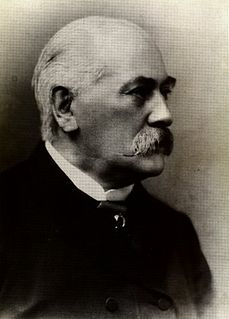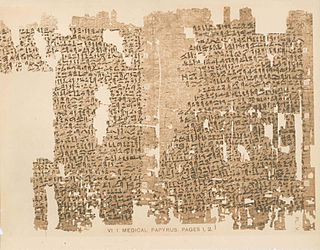 W
WEgyptian medical papyri are ancient Egyptian texts written on papyrus which permit a glimpse at medical procedures and practices in ancient Egypt. The papyri give details on disease, diagnosis, and remedies of disease, which include herbal remedies, surgery, and magical spells. It is thought there were more medical papyri, but many have been lost due to grave robbing. The largest study of the medical papyri to date has been undertaken by Berlin University and was titled Medizin der alten Ägypter.
 W
WThe Brooklyn Papyrus is a medical papyrus dating from ancient Egypt and is one of the oldest preserved writings about medicine and ophiology. The manuscript is dated to around 450 BC and is today kept at the Brooklyn Museum in New York.
 W
WThe Brugsch Papyrus, also known as the Greater Berlin Papyrus or simply Berlin Papyrus, is an important ancient Egyptian medical papyrus. It was discovered by Giuseppe Passalacqua in Saqqara, Egypt. Friedrich Wilhelm IV of Prussia acquired it in 1827 for the Berlin Museum, where it is still housed. The style of writing is that of the 19th Dynasty, and it is dated between 1350 and 1200 BC.
 W
WThe Ebers Papyrus, also known as Papyrus Ebers, is an Egyptian medical papyrus of herbal knowledge dating to circa 1550 BC. Among the oldest and most important medical papyri of ancient Egypt, it was purchased at Luxor in the winter of 1873–74 by Georg Ebers. It is currently kept at the library of the University of Leipzig, in Germany.
 W
WThe Hearst Papyrus, also called the Hearst Medical Papyrus, is one of the medical papyri of ancient Egypt. It was named after Phoebe Hearst. The papyrus contains 18 pages of medical prescriptions written in hieratic Egyptian writing, concentrating on treatments for problems dealing with the urinary system, blood, hair, and bites. It is dated to the first half of the 2nd millennium BC. It is considered an important manuscript, but some doubts persist about its authenticity.
 W
WThe Kahun Gynaecological Papyrus is the oldest known medical text in Egypt, although not the oldest in the world as in Philadelphia museum a Sumerian medical clay tablet from 3rd millennium is preserved. Dated to c. 1800 BCE, it deals with women's health—gynaecological diseases, fertility, pregnancy, contraception, etc.
 W
WThe London Medical Papyrus is an ancient Egyptian papyrus in the British Museum, London, England. The writings of this papyrus are of 61 recipes, of which 25 are classified as medical while the remainder are of magic. The medical subjects of the writing are skin complaints, eye complaints, bleeding and burns.
 W
WThe Edwin Smith Papyrus is an ancient Egyptian medical text, named after the dealer who bought it in 1862, and the oldest known surgical treatise on trauma. This document, which may have been a manual of military surgery, describes 48 cases of injuries, fractures, wounds, dislocations and tumors. It dates to Dynasties 16–17 of the Second Intermediate Period in ancient Egypt, c. 1600 BCE. The Edwin Smith papyrus is unique among the four principal medical papyri in existence that survive today. While other papyri, such as the Ebers Papyrus and London Medical Papyrus, are medical texts based in magic, the Edwin Smith Papyrus presents a rational and scientific approach to medicine in ancient Egypt, in which medicine and magic do not conflict. Magic would be more prevalent had the cases of illness been mysterious, such as internal disease.